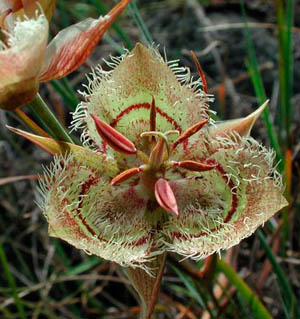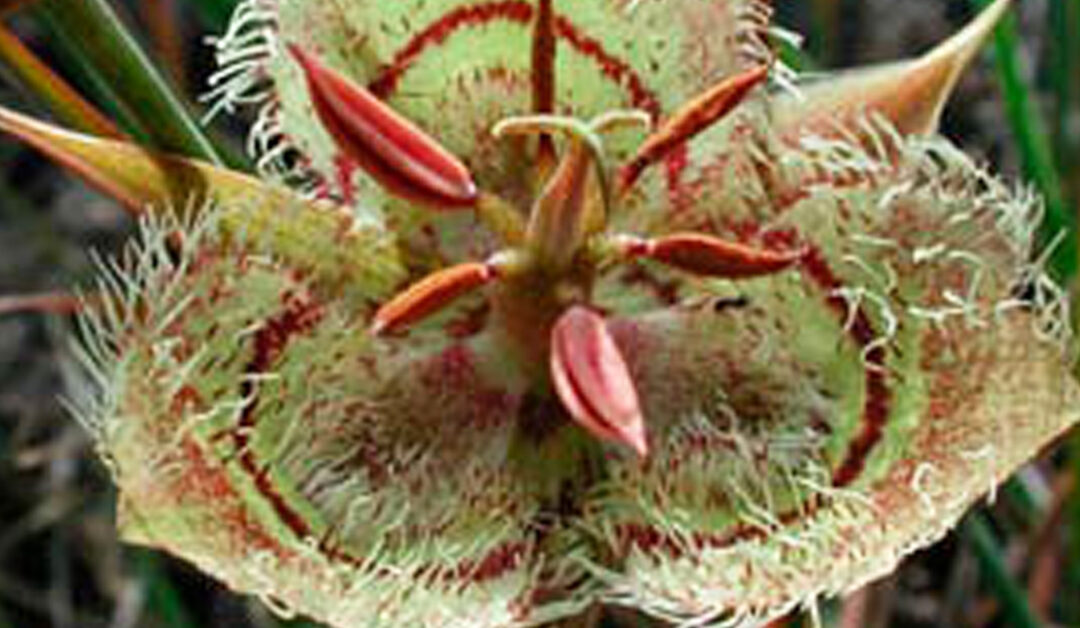Daily we drive our cars or ride the bus to the city, glad for modern transportation yet melancholy for the fate of paved-over Nature, a presumed paradise lost. But pockets of the original wilderness still flourish among our Bay Area motorways, just as a rare flower might sprout unnoticed in the middle of a sun-baked field. These natural sanctuaries are portals that can transport us to an earlier time. In Marin County, for example, where the Tiburon peninsula meets the mainland, surrounded by Corte Madera’s housing developments and adjacent to Hwy. 101, the open space preserve at Ring Mountain sustains a living connection with history, a lifeline to yesterday’s forgotten truths.
Most of present-day Ring Mountain once lay under the sea during the age of dinosaurs. Then oceanic volcanoes and tectonic movements caused massive disruptions, and the floor of the Pacific Ocean crashed into the North American plate. For a hundred million years, at the speed of one foot per decade, the collision sheared off white pillow lava and red radiolarian chert from the seabed and thrust it into the leading edge of the continent. Submarine landslides contributed tiers of primordial sand and mud (greywacke and shale), while high-pressure blueschist metamorphics like serpentinite and lawsonite bubbled up from deep inside the earth. These soapy-textured stones — mixed with thick layers of lava and petrified microscopic sea creatures fractured and buckled over eons — have brought a legion of contemporary geologists here to read the story of deep time written in Ring Mountain’s exposed rocky strata.
Growing on those serpentine odes, a native grassland tells more recent tales measured in mere thousands of years. Drought-tolerant perennial bunchgrasses push their roots twenty feet deep into the hillside, both physical and metaphoric anchors once revered by those who lived here and now all but forgotten. Their light green shoots in spring turn deeper colors in summer, and their long graceful culms nod in the breeze with a shimmering inflorescence. By nature of their adaptation to this toxic serpentine soil, these long-lived grasses were spared the invasion of exotic annuals that so transformed the majority of our state’s remaining natural areas. Here we see California as it was before the superhighway and the shopping center, before the industrial farm and the rancho, prior to the arrival of the white man.
The predominant grasses on Ring Mountain are purple needlegrass (Nassella pulchra) and foothill needlegrass (N. lepida), both densely tufted bunchgrasses from 2-3 feet tall, but closer inspection reveals other choice natives: honeygrass (Melica californica and M. torreyana), known for thin silvery florets; big squirreltail (Elymus multisetus), an aptly named bushy bunchgrass with an inflorescence like a bottlebrush; serpentine reedgrass (Calamagrostis ophiditus), beautiful with a clumping habit and feathery spikelets; and California oatgrass (Danthonia californica), a tufted fog-loving species growing only by the coast and in the Sierra above 2000 feet.
In these heady days of May, the spontaneous earth dons her finery like the god unshorn, and dances with her shadow. Our annual wildflowers passed their colorful peak in April, and now proudly sport brittle brown seedheads as offerings to the couch of death, earth’s rhythmic lover. Meanwhile, several rare species are reaching their brightest bloom. The federally threatened annual Marin dwarf flax (Hesperolinon congestum) bears clusters of small low-growing rose-white flowers now through July. The perennial Tiburon wild buckwheat (Eriogonum luteolum var. caninum) holds white-to-pink umbels into October above foot-high evergreen clumps of spreading, spoon-shaped leaves. But the mountain’s most impressive floristic gem is also its most elusive, an endemic bulb discovered here only 34 years ago.
Dr. Robert West, a physician and knowledgeable plantsman, was walking his regular route on Ring Mountain one morning in June 1970 when he noticed an unusual flower he had never seen before. Two inches in diameter and color-camouflaged to match the browning grasses behind it, the blossom was easy to miss. After much flap and fuss, botanists declared the plant a previously unknown species of mariposa lily, and named it Calochortus tiburonensis in 1973. It has not been found to occur anywhere else in the world.

With a brief bloom emerging in late May and rarely surviving June, this bulb’s fast lifecycle and restricted range rank it atop the “must-see” list of our local natural wonders. It grows among the boulders of serpentine slopes at the top of the mountain, especially along the Phyllis Ellman trail which leads right up to some noteworthy specimens. Each three-petaled blossom looks like a shallow bowl made of furry kitten ears, light green with dark red lines and spots on each petal, tufted with white curly hairs. The erect three-pronged stigma and six dark red stamens hover in the center of the flower like Cerberus riding a starfish. The whole affair is held aloft on a wiry stalk one foot high, with several flowers per stalk.
The Tiburon mariposa often grows in company with Allium lacunosum, a wild onion restricted to serpentine outcrops, so Calochortus hunters should look for the more conspicuous white to pale-pink onion flower as an indicator that the rare quarry may be near. Keep your eyes to the ground and walk as softly as the Coast Miwok who once prowled these grasslands in search of delicious and nutritious edible bulbs like mariposa lily, wild onion, blue dicks, and Ithuriel’s spear.
The ancestors of those earlier inhabitants left behind a mysterious text of primitive rock art carved into the blueschist outcrops and boulders of this region. These carvings are typically single or attached circles or ovals with a raised center, faded by the millennia and often difficult to see unless hit by the sun at the proper angle. We don’t know the exact age of the petroglyphs, nor their specific ceremonial purpose — but they speak with the authority of a distant yet connected past, like a faint voice reaching us from the time before memory.
The vista from Ring Mountain embraces 360 degrees — including nearby Mt. Tam and distant Mt. Diablo, glamorous San Francisco and dangerous San Quentin — but the true sense of vertigo derives from all that human and natural history converging here, linking the dead to the living. The more we learn, the more we realize how much more there is to learn. Despite our vast advances of science and technology in recent centuries, we never even noticed Calochortus tiburonensis until a few years ago. How can we verify the integrity of our knowledge? What other clues have we missed? Three minutes by car from the freeway, yet worlds removed from civilization, Ring Mountain remains ours for the exploration, an island of the ancient in a pulsing sea of the new.
* * *
Writer and Madroño founder Geoffrey Coffey believes those circular petroglyphs are early drawings of Calochortus tiburonensis. Find other far-fetched hypotheses at www.geoffreycoffey.com.

Madroño president Geoffrey Coffey started the company in 2005 out of the back of a pickup truck. His garden column, “Locals Only”, first appeared in the San Francisco Chronicle in 2002. He lives in San Francisco with his wife and two children, where he also sings and thumps the bass for Rare Device.


